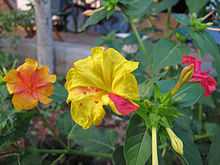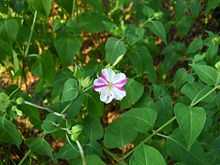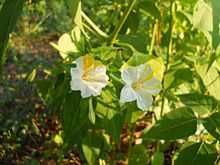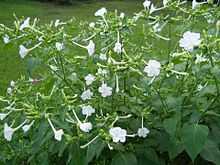Mirabilis jalapa
| Mirabilis jalapa | |
|---|---|
| | |
| Scientific classification | |
| Kingdom: | Plantae |
| (unranked): | Angiosperms |
| (unranked): | Eudicots |
| (unranked): | Core eudicots |
| Order: | Caryophyllales |
| Family: | Nyctaginaceae |
| Genus: | Mirabilis |
| Species: | M. jalapa |
| Binomial name | |
| Mirabilis jalapa L. | |
Mirabilis jalapa (the four o'clock flower or marvel of Peru) is the most commonly grown ornamental species of Mirabilis, and is available in a range of colours. Mirabilis in Latin means wonderful and Jalapa is a not uncommon placename in Central and North America. Mirabilis jalapa is said to have been exported from the Peruvian Andes in 1540.
Flowers and color
A curious aspect of this plant is that flowers with different colors can be found simultaneously on the same plant.



Additionally, an individual flower can be splashed with different colors. Flower patterns are referred to as sectors (whole sections of flower), flakes (stripes of varying length), and spots. A single flower can be plain yellow, pink or white, or have a combination of sectors, flakes and spots. Furthermore, different combinations of flowers and patterns can occur on different flowers of the same plant.[1]
Another interesting point is a color-changing phenomenon. For example, in the yellow variety, as the plant matures, it can display flowers that gradually change to a dark pink color. Similarly white flowers can change to light violet.

The flowers usually open from late afternoon onwards, hence the first of its common names. Flowers then produce a strong, sweet-smelling fragrance throughout the night, then close for good in the morning. New flowers open the following day.
Despite their appearance, the flowers are not formed from petals – rather they are a pigmented modification of the calyx. Similarly, the 'calyx' is an involucre of bracts.[2]
The flowers are pollinated by long-tongued moths of the Sphingidae family, such as the sphinx moths or hawk moths and other nocturnal pollinators attracted by the fragrance.[3]
Common names
- In Pakistan it is called gul adnan (Urdu: گل عدنان), gul-e-abbas (Urdu: گل عباس).
- In Sri Lanka it is called hendirikka (හෙන්දිරික්කා).
- In Karnataka it is called sanje mallige ಸಂಜೆ ಮಲ್ಲಿಗೆ
- In Tamil Nadu it is called andhi mandhaarai (Tamil: அந்தி மந்தாரை).
- In Andhra Pradesh it is called chandrakantha&indraganti (Telugu: చ౦దరకా౦త&indraganti).
- In Kerala it is called naalumani poovu (Malayalam: നാലുമണിപ്പൂ, പതിറ്റടിമുല്ല).
- In Maharashtra it is called gulabakshi (Marathi: गुलबक्षी).
- In Assamese it is called godhuli gopal, godhuli meaning "evening".
- In Bengali it is called sandhyamaloti (সন্ধ্যামালতি).
- In Maithili it is called sanjhaa phool as it blooms in evening.
- In Oriya it is called rangani.
- In Punjabi it is called sham di sohnap which means evening beauty.
- In Indonesia it is called bunga pukul empat.
- In China it is called the "shower flower" (Chinese: 洗澡花; pinyin: xǐzǎo huā) or "rice boiling flower" (simplified Chinese: 煮饭花; traditional Chinese: 煮飯花; pinyin: zhǔfàn huā) because it is in bloom at the time of these activities.
- In Hong Kong it is known as "purple jasmine" (紫茉莉).
- The Turkish name is akşam sefası, which means "evening pleasure".
- In the Netherlands and in France the name of the plant is Nachtschone and belle de nuit respectively meaning "beauty of the night".
- In Persian it is called laleh abbasi (لاله عباسی).
- In Japan it is called oshiroi-bana, as the white, powdery endosperm inside of mature seeds looks like oshiroi, the powder foundation used by geishas.
- In Hebrew it is called Lilanit Rav-Gonit (לילנית רב-גונית)- meaning "Queen of the night".
- In Namibia it is called Vieruurtjie as it starts to open at 16:00 until the morning
- In Slovenia it is called "Nočna frajlica" - meaning "Night missy"
- In Romania it is called "Barba imparatului"-meaning "Emperor beard"
Habitat and cultivation
M. jalapa hails from tropical South America, but has become naturalised throughout tropical and warm temperate regions. In cooler temperate regions, it will die back with the first frosts, regrowing in the following spring from the tuberous roots. The plant does best in full sun. It grows to approximately 0.9 m in height. The single-seeded fruits are spherical, wrinkled and black upon maturity (see picture), having started out greenish-yellow. The plant will self-seed, often spreading rapidly if left unchecked in a garden. Some gardeners recommend that the seeds should be soaked before planting, but this is not totally necessary. In North America, the plant perennializes in warm, coastal environments, particularly in USDA Zones 9–10.
Genetic studies
Around 1900, Carl Correns used Mirabilis as a model organism for his studies on cytoplasmic inheritance. He used the plant's variegated leaves to prove that certain factors outside the nucleus affected phenotype in a way not explained by Mendel's theories.[4] Correns proposed that leaf color in Mirabilis was passed on via a uniparental mode of inheritance.[4]
Also, when red-flowered plants are crossed with white-flowered plants, pink-flowered offspring, not red, are produced. This is seen as an exception to Mendel's Law of Dominance, because in this case the red and white genes are of equal strength, so neither completely dominates the other. The phenomenon is known as incomplete dominance.
Chemistry
Eight betaxanthins (indicaxanthin, vulgaxanthin-I, miraxanthin-I, -II, -III, -IV, V and -VI) can be isolated from M. jalapa flowers.[5]
Rotenoids (mirabijalone A, B, C ans D, 9-O-methyl-4-hydroxyboeravinone B, boeravinone C and F, and 1,2,3,4-tetrahydro-1-methylisoquinoline-7,8-diol) can be isolated from the roots.[6]
A fatty acid (8-hydroxyoctadeca-cis-11,14-dienoic acid) is found as a minor component in the seed oil.[7]
Analysis of the methanolic extract of the aerial parts yields β-sitosterol, stigmasterol, ursolic acid, oleanolic acid and brassicasterol.[8]
Bioassay-guided fractionation of an organic extract of the cell mass from a manipulated plant cell culture of M. jalapa led to the isolation and subsequent identification of an isoflavone, a roteinoid and a dehydrorotenoid, Two of this compounds are responsible for the antimicrobial activity against Candida albicans.[9]
Bioassay-guided fractionation of the methanolic extract of M. jalapa also led to the isolation of an active polyphenolic amide: N-trans-feruloyl 4′-O-methyldopamine. This compound shows moderate activity as an efflux pump inhibitor against multidrug-resistant Staphylococcus aureus.[10]
Uses
The flowers are used in food colouring. The leaves may be eaten cooked as well, but only as an emergency food.[11]
An edible crimson dye is obtained from the flowers to colour cakes and jellies.[11]
In herbal medicine, parts of the plant may be used as a diuretic, purgative, and for vulnerary (wound healing) purposes. The root is believed an aphrodisiac as well as diuretic and purgative. It is used in the treatment of dropsy.
The leaves are used to reduce inflammation. A decoction of them (mashing and boiling) is used to treat abscesses. Leaf juice may be used to treat wounds.
Powdered, the seed of some varieties is used as a cosmetic and a dye.[11] The seeds are considered poisonous.[12]
The plant has a potential for the bioremediation of soils polluted with moderate concentrations of heavy metals such as cadmium.[13]
References
- ↑ "Investigations of the inheritance of flower variegation in Mirabilis jalapa L. 1. General introduction and 2. Inheritance of colour in uniformly coloured flowers. J.M.M. Engels, W.N.M. van Kester, C.J.T. Spitters, L. Vosselman, A.C. Zeven. Institute of Plant Breeding, Agricultural University, Wageningen.".
- ↑ J. Hutchinson, 1969. Evolution and phylogeny of flowering plants. London.
- ↑ "UCLA Mildred E. Mathias Botanical Garden". Botgard.ucla.edu. Retrieved 2012-07-31.
- ↑ 4.0 4.1 Miko, I. Non-nuclear genes and their inheritance. Nature Education 1(1), (2008)
- ↑ Pigments of centrospermae—V. : Betaxanthins from Mirabilis jalapa L. M. Piattelli, L. Minale and R.A. Nicolaus, , Phytochemistry, 1965, Volume 4, Issue 6, Pages 817–823 (abstract)
- ↑ New Rotenoids from Roots of Mirabilis jalapa. Wang Yi-Fen, Chen Ji-Jun, Yang Yan, Zheng Yong-Tang, Tang Shao-Zong and Luo Shi-De, Helvetica Chimica Acta, August 2002, Volume 85, Issue 8, pages 2342–2348, doi:10.1002/1522-2675(200208)85:8<2342::AID-HLCA2342>3.0.CO;2-S
- ↑ An 8-hydroxyoctadeca-cis-11,14-dienoic acid from Mirabilis jalapa seed oil. Mohammad Shamim Ahmad, Abdul Rauf, Jamal Mustafa and Mohammad Osman Sheikh, Phytochemistry, 1984, Volume 23, Issue 10, Pages 2247–2249 (abstract)
- ↑ Constituents of Mirabilis jalapa. Siddiqui S., Siddiqui B.S., Adil Q. and Begum S., Fitoterapia, 1990, Volume 61, No. 5, page 471 (abstract)
- ↑ Three New Phenolic Compounds from a Manipulated Plant Cell Culture, Mirabilis jalapa. Shu-Wei Yang, Rosa Ubillas, James McAlpine, Angela Stafford , Dawn M. Ecker, M. Kelly Talbot and Bruce Rogers, J. Nat. Prod., 2001, volume 64, issue 3, pages 313–317, doi:10.1021/np0004092
- ↑ N-Caffeoylphenalkylamide derivatives as bacterial efflux pump inhibitors. Serge Michalet, Gilbert Cartier, Bruno David, Anne-Marie Mariotte, Marie-Geneviève Dijoux-franca, Glenn W. Kaatz, Michael Stavri and Simon Gibbons, Bioorganic & Medicinal Chemistry Letters, 15 March 2007, Volume 17, Issue 6, Pages 1755–1758 (abstract)
- ↑ 11.0 11.1 11.2 "Mirabilis jalapa Marvel Of Peru PFAF Plant Database". Pfaf.org. Retrieved 2012-07-31.
- ↑ "h2g2 - Four O'Clocks - Night Blooming Beauties". Bbc.co.uk. 2002-08-20. Retrieved 2012-07-31.
- ↑ Growth responses and cadmium accumulation of Mirabilis jalapa L. under interaction between cadmium and phosphorus. Yu Z and Zhou Q, J Hazard Mater., 15 August 2009, volume 167, issues 1-3, pages 38-43, doi:10.1016/j.jhazmat.2008.12.082
Further reading
- Correns, C. Vererbungsversuche mit blass (gelb) grünen und buntblättrigen Sippen bei Mirabilis, Urtica und Lunaria. ZIAV 1, 291–329 (1909)
- Pierce, B. Genetics: A Conceptual Approach, 2nd ed. (New York, Freeman, 2005)
| Wikimedia Commons has media related to Mirabilis jalapa. |